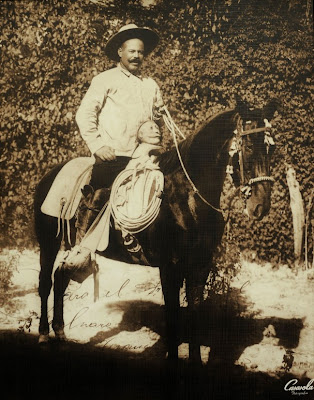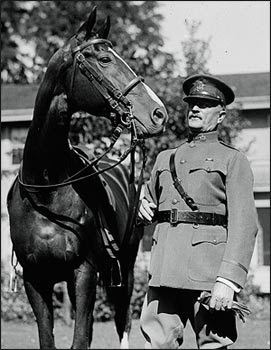“Riding with Pancho Villa,” a new photography exhibit, has just opened in Abilene, Texas, celebrating the centennial of the Mexican Revolution, and held in conjunction with events honoring the founding of the Republic of Texas (1836-46).
Hosting the events is Frontier Texas!, a nearly seven-acre Disneyland-meets-the-Wild-West historical theme park of sorts, designed to revive “the Old West with the help of state-of-the-art technology.” A museum in which visitors can get up close and personal, virtually anyway, with the “people who played out their lives on the Texas frontier.” Frontier Texas’s “cutting-edge technology puts a visitor in the middle of attacks by Indians and wolves, stampeding buffalo, a card game shootout and a prairie thunderstorm, even a lovely spring evening filled with fireflies.” (No word on amusements depicting the fun of Americans attacking and scalping Native Americans.)
Included in this celebration is an exhibit of over 40 rare historical photographs brought to the US by the legendary “outlaw,” Francisco “Pancho” Villa‘s 25-year-old great-grandson, Francisco Villa. It was no simple task to bring these photos to the US from Villa the younger’s native Mexico. Due to Mexico’s stringent policy regarding protection of it’s cultural heritage and artifacts, Villa was required to submit documents signed by authorized US experts guaranteeing that the images were not being imported for sale, but only for temporary exhibit purposes. Fortunately, Villa, being a political science student at Abilene Christian University, was able to secure letters to this effect from the university’s Office of Multicultural Enrichment. And the photos made it across the border and into Texas without a hitch.
 Pancho Villa’s Great Grandson, Francisco Villa (right)
Pancho Villa’s Great Grandson, Francisco Villa (right)Discusses Exhibit With Frontier Texas! Executive Director Jeff Salmon.
(Photo courtesy of Nellie Doneva, www.reporternews.com.)
Francisco Villa’s father, Agustin Villa, had been exhibiting these photos in Mexico City at various museums and other select repositories in his country for the past several years. A decade ago, Francisco began attending school in the Dallas/Fort Worth area. “At some point we decided that since I was going to be here it was a good idea to bring [the photos] to the U.S.” for what would be a first-time domestic exhibition.
Pancho Villa is, of course, the legendary Mexican Revolutionary general-“outlaw”-“bandit,” killer, revolutionary leader, and folk hero (depending which side of the border you’re on), especially revered in his native Mexico. Villa (1878-1923) was justifiably notorious for his unique style of guerrilla-like depredations, several into Texas, most most notably in 1916. His raid on Columbus, New Mexico in 1916, earned him the enmity of the US and lead to the famous year-long ultimately futile “Punitive Expedition” incursion into Mexico by the equally legendary US Army General John J. (“Black Jack”) Pershing, at the head of some 4,500 soldiers. (“Old Blood and Guts” General George S. Patton was at the time one of Pershing’s aides.)
After the Revolution somewhat ended in 1920, Villa, who had briefly semi-retired, once again became active in politics and was assassinated in 1923, under circumstances still clouded in mystery. (Most standard sources claim it was the result of a well-planned conspiracy by Mexican generals with the approval of Mexico’s President Álvaro Obregón, who was himself assassinated a few years later.)
 The Usual Suspects: (Left To Right) Generals Obregon, Villa and Pershing,
The Usual Suspects: (Left To Right) Generals Obregon, Villa and Pershing,Fateful Meeting at meeting at Ft Bliss, Tx, 1914.
(George S. Patton, Jr., Directly behind Pershing).
(Courtesy www.reporternews.com).
Pancho Villa led a rich, extensively documented life, well at odds with what Americans at the time thought of as respectable. Francisco Villa says of his great-grandfather “He had two things he really liked – women and cock fights.” Yes, he loved the women: (And he AND his women presumably loved cocks.) roping in some 20-23 wives, several of whom he tied the knot with simultaneously. (Francisco’s great-grandmother, Manuela Casas, married Villa around 1920.)
The exhibit, is comprised of photos acquired from the Casasola Archives, widely acclaimed as the most richly detailed collection of images documenting Mexico’s history in the early 20th century. Agustín Casasola (1874-1928), was a photographer and author who created Mexico’s first press agency in 1911, and in 1917 published the famous Album histórico gráfico, which was intended to be a complete photographic record of the Mexican Revolution. (Unfortunately only the first six volumes, covering 1910-1912, were actually published.) The Casasola collection, well over 500,000 prints and negatives, is now housed at the Casasola Archives at the Instituto Nacional de Antropología e Historia.
Of all the photographs, the one most treasured by Francisco is an image of Pancho Villa surrendering after a bloody ten-year campaign against the Mexican government. He says, “You can see in his face that he is not tired, he understands he must go through another way. You can tell [his soldiers] are burned from the desert, they are all dirty.”
 Pancho Villa And Soldiers Sign Act of Surrender, July 28, 1920.
Pancho Villa And Soldiers Sign Act of Surrender, July 28, 1920.(Courtesy www. latinamericanstudies.org.)
Captions for the Frontier Texas! exhibit are, appropriately, bilingual with text in both English and Spanish, each accompanied with a quote from one of Villa’s biographies. Jeff Salmon, executive director of Frontier Texas!, says of this exhibit: “it allows us to show a piece of history that deserves discussion. Although Villa is a controversial figure to many – it was a very important time in history. The photos are a fascinating look at a particular time and place in history.”
Also highlighted in the exhibit are documents relating to the bicentennial of Diez y Seis de Septiembre (Sept. 16, 1810), when Mexico won its freedom from Spain. The exhibit continues at Frontier Texas until May 28, 2010. Other activities in this celebration are listed on the Frontier Texas! homepage. If successful, Francisco Villa and his family hope to take the exhibit on tour across Texas and the US. Pancho Villa had at least 23 children with various wives, so more great-grandchildren are bound to turn up somewhere on the exhibit’s ride.



